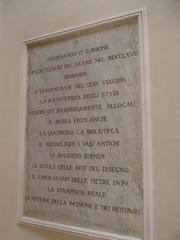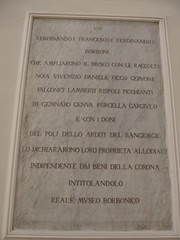King Ferdinand I of Naples of Sicily of the Two Sicilies


King Ferdinand I of Naples of Sicily of the Two Sicilies
(1751-1825)
King of Naples (1759-1799), King of Sicily (1759-1816), King of Naples (1799-1806), King of Naples (1815-1816), and King of the Two Sicilies (from 1816)
Family tree
Commemorated on 3 plaques
III. Ferdinando IV Borbone Espulsi i gesuiti dal reame nel MDCCLXVII ordinava si trasportasse nel gesu vecchio la R. Universita degli studi fossero qui splendidamente allogati il Museo Ercolanese la quadreria la Biblioteca il medagliere i vasi antichi vi avessero stanza le scuole delle arti del disegno il lavoratorio delle Pietre dure la stamperia reale le officine della incisione e dei restauri
Museo Archeologico Nazionale di Napoli, Napoli, Italy where they expelled Jesuits from the realm
VIII. Ferdinando I. Francesco I. Ferdinando II Borboni Che ampliarono il museo con le Raggolte noia vivenzio Daniele Ficco Cervone falconet Lamberti Rispoli Picchianti di Gennaro Genua Forcella Gargiulo e con i doni del poli dello arditi del Sangiorgio lo dichiararono loro proprieta allodiale indipendente dai beni della corona intitolandolo Reale Museo Borbonico
Museo Archeologico Nazionale di Napoli, Napoli, Italy where they expanded the museum
V. Ferdinando IV Borbone fuggendo di Napoli il XXI Dicembre MDCCXCVIII e nel XXIII Gennaio MDCCCVI traeva seco in Palermo i piu insigni monumenti in questo luogo raccolti altri ne involava in nome della liberta il vincitore straniero nel MDCCIC ma quei tesori qui facevano avventurosamente ritorno nel MDCCCI e nel MDCCCXVII
Museo Archeologico Nazionale di Napoli, Napoli, Italy where they fled Naples



